Headmount computer design runs Linux
Nov 4, 2009 — by Eric Brown — from the LinuxDevices Archive — 22 viewsHardware hacker Pascal Brisset has unveiled a Linux-driven head-mounted computer based on a stereoscopic, 640 x 480 Vusix VR920 headmount display and the Gumstix Overo Fire module running the ARM Cortex-A8 OMAP3530 processor from Texas Instruments. The six-ounce WXHMD computer includes WiFi, Bluetooth, accelerometers, compass, and a custom-made DAC board.
Brisset published full specifications and schematics of the WXHMD prototype on his PABR.org site, where he has also published other Linux-based device and software projects over the last decade, including a microhelicopter (pictured at end of story), a home server, and most recently, direct-to-PCB inkjet printing techniques. The PCB techniques were used in the development of the WXHMD's custom DAC breakout board, the chief component in the headmount computer that was designed by Brisset himself.
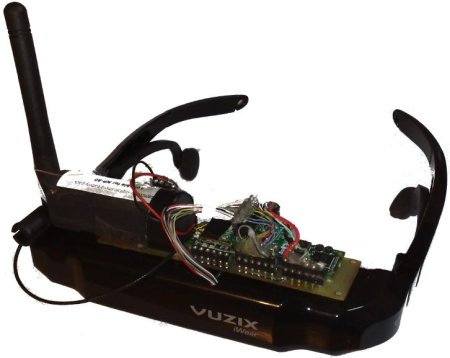
WXHMD, showing battery (left) and Overo Fire module and DAC (right) strapped to top of VR920 headmount
(Click to enlarge)
Launched almost exactly a year ago, the Overo Earth family of COMs was billed as the next generation successor to the popular 3.2 x 0.8 x 3.2-inch Gumstix Verdex modules. The Overo Earth is 40 percent smaller than the Verdex, but instead of a Marvell PXA270 processor, it offers the more powerful TI OMAP35xx SoC. Although clocked similarly at 600MHz, the OMAP35xx offers faster performance, thanks to its ARM Cortex-A8 superscalar core, which enables instruction-level parallelism within a single processor.
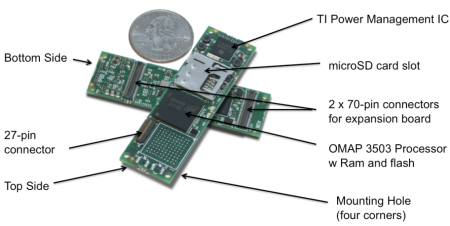
Overo Earth module
(Click to enlarge)
In April, the Overo family was expanded with similarly sized modules including the WiFi-enabled Overo Air, which incorporates the basic OMAP3503 model in the OMAP35xx line. Gumstix also added the Overo Water (OpenGL graphics) and Overo Fire (OpenGL, WiFi, and Bluetooth) modules, both of which incorporate the multimedia-enhanced OMAP3530.
All four Overo modules are equipped with 256MB of low-power DDR RAM and 256MB of NAND flash, says Gumstix. The company recently announced a new Palo35 expansion board for the Overo modules that supports a 3.5-inch LCD touchscreen.
Brisset chose to use the most advanced Overo module, the Overo Fire, which saved him from having to add WiFi and Bluetooth. Clocked at up to 600MHz, the module is further equipped with USB OTG, which supplies a maximum of 100 mA, and LCD digital video signals are output at 1.8 V. The Overo Fire must be interfaced via dual 70-pin 0.4 mm-pitch SMD connectors, says the developer.
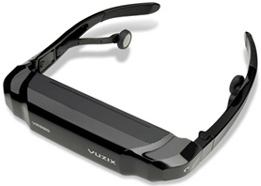
Vusix VR920
To bridge the VR920 and the Overo Fire module, Brisset built a tiny breakout board "with decently sized connectors for power and USB," as well as simple resistor-based digital-to-analog converters (DACs) for analog video output, says the developer. The DACs are said to connect to OMAP3530's digital LCD output to produce 12 bpp signals (4 bits per component). The LCD sync signals from the OMAP are then routed to their matching VGA pins. The double-sided PCB was designed with gEDA gschem, laid out with gEDA PCB, and etched by Direct Inkjet Resist Printing, says Brisset.
One interesting problem emerged in that Brisset discovered that the 13-pin connector inside the VR920 was incapable of receiving raw VGA and USB signals. He soon found that the VGA/USB signal splitter was instead located in the USB cable, thanks to a tiny circuit board that pre-processes VGA sync signals. The solution, as shown in the image below: "I simply merged this board into the design."
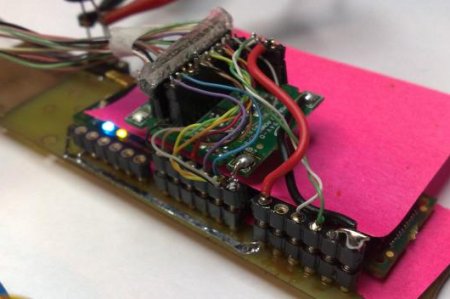
Video splitter board merged onto Overo Fire
(Click to enlarge)
All told, the system draws 1 Amp with no power optimizations, says Brisset. He notes somewhat wryly that this "is acceptable since nobody would want to spend more than a few minutes with two pulsed microwave RF transmitters, an overheating lithium battery and eye-straining optics strapped to their forehead anyway."
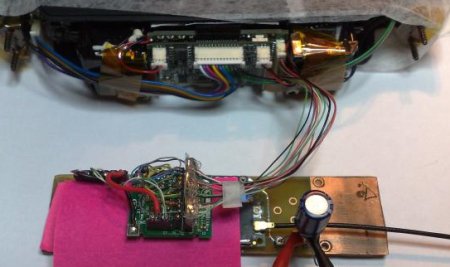
WXMD prior to final assembly
(Click to enlarge)
WXHMD showing Firefox browser session. Distortions are exaggerated by difficulties in photographing stereophonic optical assembly, and could be solved with higher quality DACs, says Brisset.
(Click to enlarge)
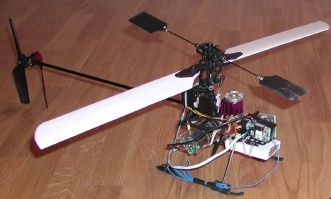
Brisset's earlier Linux-based microhelicopter design
PABR.org has published schematics and other details for the WXHMD headmount display, but does not appear to mention licensing for the design. More information may be found here.
This article was originally published on LinuxDevices.com and has been donated to the open source community by QuinStreet Inc. Please visit LinuxToday.com for up-to-date news and articles about Linux and open source.
